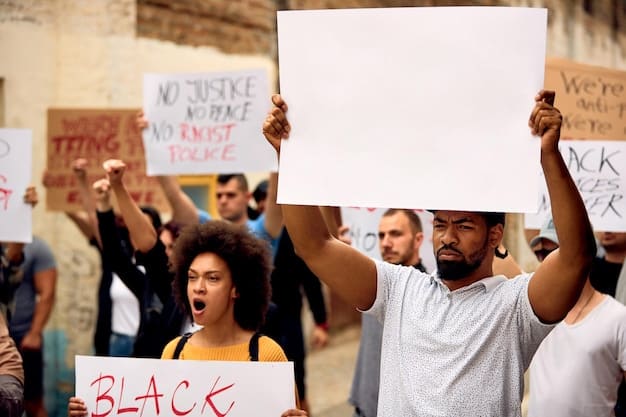The Power of Collective Action: US Social Justice Movements

The power of collective action is evident in numerous successful social justice movements throughout U.S. history, demonstrating how unified efforts can drive significant change and shape a more equitable society.
The power of collective action: case studies of successful social justice movements in the US illustrate the incredible impact that organized groups of individuals can have on society. From the Civil Rights Movement to more contemporary struggles, these movements demonstrate the effectiveness of uniting for a common cause. But how do these movements achieve their goals and what makes them successful in the long run?
Understanding the Essence of Collective Action
Collective action is the coordinated effort of a group of people to achieve a shared objective. In the context of social justice, this usually involves addressing systemic inequities, advocating for policy changes, and challenging oppressive structures. Understanding the ingredients that make a movement successful is essential to empowering future advocates.
The idea thrives on the notion that together, individuals can create a force multiplier effect, amplifying their potential and making it harder for institutions to ignore their demands. Whether it is through protests, advocacy, policy reform, or all of the above, the core remains the same: people organizing to achieve a common goal.

Key Elements of a Successful Social Justice Movement
Numerous factors contribute to the success of a social justice movement. These can range from clear goals to diverse leadership. Let’s take a look:
- Clear Objectives: A successful movement must have well-defined, achievable goals.
- Strong Leadership: Effective leaders unite and inspire members.
- Strategic Planning: Movements need strategies, including tactics for advocacy and protest.
- Community Engagement: Broad support from the community bolsters the movement’s legitimacy.
In essence, collective action requires a mix of vision, organization, and dedication. When these elements coexist, the chances of a movement gaining traction increases exponentially. It takes a collective effort to transform society.
In conclusion, understanding the dynamics of collective action hinges on the understanding that united, organized people have the power to influence change. It involves clear objectives, leadership, strategic planning, and community engagement.
The Civil Rights Movement: A Paradigm of Unity and Perseverance
The Civil Rights Movement stands as one of the most transformative examples of collective action in U.S. history. With a focus on ending racial segregation and discrimination, the movement rallied millions, setting a precedent for future generations.
It was an era marked by powerful protests, legal battles, and significant legislative victories. The movement’s dedication to nonviolent resistance played a pivotal role in its widespread acceptance and long-term change.
The Montgomery Bus Boycott: A Case Study in Targeted Action
The Montgomery Bus Boycott, which began with Rosa Parks, showed the power of economic pressure and collective refusal. The boycott lasted for over a year, crippling the city’s bus system and highlighting the economic impact of the African American community.
- Rosa Parks’ Refusal: Sparked the boycott and ignited widespread resistance.
- Economic Impact: Hurt the bus system, forcing Montgomery officials to address segregation.
- Lasting Change: Led to the desegregation of the bus system and was a catalyst for future action.
The Montgomery Bus Boycott serves as a powerful example of how targeted, sustained collective action can lead to substantial change, setting a benchmark for future movements.
In summary, the Civil Rights Movement, with events like the Montgomery Bus Boycott, serves as a testament to the transformative power of collective action and civil resistance. Through unity, perseverance, and strategic planning, this movement secured significant legislative victories and reshaped the fabric of American society.
The Women’s Suffrage Movement: A Century-Long Fight for Voting Rights
The Women’s Suffrage Movement was a decades-long struggle to win women the right to vote. From the mid-19th century to 1920, activists employed various tactics, demonstrating remarkable resilience and strategic adaptation.
This movement eventually led to the passage of the 19th Amendment, a pivotal moment in American history that acknowledged women’s participation in democracy. The suffragists faced setbacks, imprisonment, and public ridicule, but their unwavering dedication eventually paid off.
Strategies of the Suffragists: From Marches to Political Lobbying
The women’s suffrage movement adopted diverse strategies to achieve their goals. These included peaceful marches, civil disobedience, and persistent political lobbying.
- Marches and Protests: Displayed public support and raised awareness.
- Civil Disobedience: Drew attention to the cause through principled resistance.
- Political Lobbying: Persuaded lawmakers to support the 19th Amendment.
These tactics, combined with strong leadership and robust community support, played a crucial role in securing women’s suffrage.
In conclusion, the Women’s Suffrage Movement illustrates how strategic diversity, resilience, and long-term commitment can lead to fundamental changes in social and political structures. The 19th Amendment stands as a symbol of their commitment.

The LGBTQ+ Rights Movement: From Stonewall to Marriage Equality
The LGBTQ+ Rights Movement has transformed U.S. society within a relatively short period. Originating from the Stonewall Riots in 1969, the movement has fought for decriminalization, social acceptance, and legal protections.
Over decades, LGBTQ+ activists have achieved notable victories, including the legalization of same-sex marriage nationwide. However, the movement also continues to face challenges, highlighting that advocacy needs to be sustainable.
The Fight for Marriage Equality: A Landmark Achievement
The battle for marriage equality showcased the movement’s capacity in using impact litigation and public advocacy. By strategically targeting specific cases and cultivating broad social support, activists shifted public opinions.
- Legal Challenges: Landmark cases like Obergefell v. Hodges established the constitutional right to same-sex marriage.
- Public Advocacy: Normalizing LGBTQ+ relationships through media and community engagement.
- Policy Changes: Securing protective steps to prevent discrimination.
The fight for marriage equality not only granted legal rights but also fostered greater acceptance and understanding across society. It emphasizes that collective advocacy can transform the status quo.
In conclusion, the LGBTQ+ Rights Movement illustrates the transformative power of sustained collective action, strategic litigation, and extensive public advocacy. This movement has secured legal rights, challenged societal norms, and has led the way for a more inclusive America.
Environmental Movements: Combating Climate Change and Promoting Sustainability
Environmental movements in the U.S. address pressing issues such as climate change, pollution, and conservation. By combining grassroots activism with scientific expertise, these movements drive efforts for sustainable policies.
These movements range from local initiatives to national campaigns, aiming to safeguard natural resources and promote environmental justice. These groups face the challenge of countering powerful forces but show us that organized action is important.
Key Campaigns and Strategies: From Protests to Policy Advocacy
Environmental movements employ a series of strategies, including protests, legal action, and policy advocacy, to safeguard natural resources.
- Protests and Demonstrations: Raise awareness and pressure policymakers to act.
- Legal Action: Challenges environmentally destructive projects in court.
- Policy Advocacy: Lobbies for legislation that protects the environment.
Through these multifaceted approaches, environmental movements strive to create a more sustainable and just future for all.
In conclusion, environmental movements illustrate the crucial role of collective action in addressing complex environmental challenges. By integrating grassroots engagement, scientific expertise, and strategic advocacy, these movements strive for a viable future.
Labor Movements: Championing Workers’ Rights and Economic Justice
Labor movements in the United States aim to improve workers’ rights, wages, and working conditions. These movements are crucial in providing economic justice and fair treatment in the workplace.
Through strikes, negotiations, and policy advocacy, labor movements fight for fair labor practices. Although the labor movement faces challenges, the movements continue to be a force for change, highlighting the importance of collective bargaining and worker empowerment.
Historic Strikes and Lasting Impacts: Shaping Labor Laws
Labor movements have executed historical strikes and worker empowerment efforts and are still doing such today to shape labor laws, making workplaces safer.
- Strikes and Boycotts: Disrupt economic output in protest of poor conditions and low pay.
- Collective Bargaining: Negotiates better contracts for workers.
- Policy Advocacy: Lobbies for labor legislation to protect workers’ rights.
Through these direct encounters and advocacy initiatives, labor movements strive to establish fair labor standards, and offer safer working conditions.
In conclusion, labor movements underscore the power of collective action in promoting workers’ rights and ensuring economic justice. Through a combination of direct action, collective bargaining, and policy advocacy, these movements empower workers and drive positive change in the workplace.
| Key Point | Brief Description |
|---|---|
| ✊ Civil Rights | Addressed segregation through boycotts and protests. |
| 🗳️ Women’s Suffrage | Secured voting rights via marches and political lobbying. |
| 🏳️🌈 LGBTQ+ Rights | Achieved marriage equality via litigation and advocacy. |
| 🌎 Environmental Issues | Fights for sustainability through protests and policy changes. |
Frequently Asked Questions
▼
Collective action in social justice refers to coordinated efforts by a group to achieve a common objective, such as addressing inequities, advocating for policy changes, and challenging oppressive structures.
▼
The Civil Rights Movement used a wide array of strategies, including nonviolent resistance, legal challenges, economic boycotts, and peaceful protests to combat racial segregation and discrimination.
▼
The Women’s Suffrage Movement combined marches, civil disobedience, and political lobbying, pressuring lawmakers to support the 19th Amendment, which granted women the right to vote in 1920.
▼
The Stonewall Riots in 1969 marked a turning point for the LGBTQ+ rights movement, sparking increased activism and advocacy for decriminalization, social acceptance, and legal protections.
▼
Environmental movements employ diverse methods such as protests, grassroots activism, legal action, and policy advocacy to advocate for sustainable practices and combat climate change at the local and national levels.
Conclusion
The power of collective action is evident in the various U.S. social justice movements. By uniting people to strive for a shared vision, movements achieve far-reaching changes transforming society on many levels. By examining successful historical and contemporary collective movements, we are better able to understand and realize the impact that these actions have had, and will continue to have on society.





